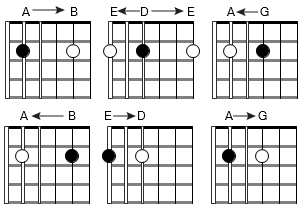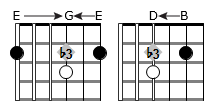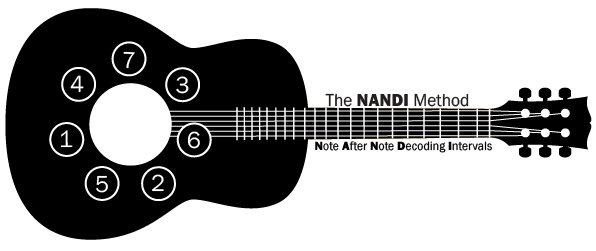If you have been searching for an alternative approach to memorizing the shapes of the fretboard, the NANDI Method can provide a simple solution. Here you will learn the most efficient way to identify the closest locations of intervals and the inversions of those intervals on non-adjacent strings. Plus, the NANDI Method uses fretboard logic, creating a more practical application.
Major Seconds & Minor Sevenths
The seven degrees of the major scale are as follows: 1-2-3-4-5-6-7.
A major second can be found between all of the intervals except for 3 and 7.
When these seconds are inverted, we get minor sevenths from the scale degrees 2, 3, 5, 6, and 7:
2-1, 3-2, 5-4, 6-5, 7-6

The NANDI Method provides guitarists with a novel way of determining interval locations. It does so by utilizing the pitch distance between the notes of open strings as a helpful reference.
To give you some context, let’s look at the major second. We know that the distance of a major second exists between the open notes A and B, D and E, and G and A. This indicates that any two notes or numbers found on the same fret of the A-B, D-E, and G-A strings, are also a major second apart. If we look at this pattern in reverse, we can see that these notes have a minor seventh relationship on the B-A, E-D, and A-G strings.
Major seconds and minor sevenths are inversions of one another. If you want to learn about the fundamentals of interval inversions, make sure to check out the lesson titled “Inversion Basics“.

Minor Seconds & Major Sevenths
The sevenths are built atop the 1 and the 4 are major in quality. These include:
1-7, 4-3
The two minor seconds, which occur naturally within the major scale, become major sevenths when they are reversed:
7-1, and 3-4.

Minor Thirds & Major Sixths
Minor thirds can be found on four scale degrees:
7-2, 3-5, 6-1, 2-4.
Major sixths are inversions of minor thirds:
2-7, 5-3, 1-6, 4-2

If we use the minor third relationship between the open notes E and G and B and D as references, we can come to the conclusion that a minor third relationship exists between any two notes located on the same fret of the E-G and B-D strings.
If we look at those same notes or string in reverse order, we get inversions of minor thirds (major sixths), which are found on the G-E and D-B strings.

Major Thirds & Minor Sixths
We find major thirds when we look at the other three natural scale degrees:
5-7, 1-3, 4-6

A major third sits one fret up from a minor third on the E-G and B-D strings. When inverted, major thirds become minor sixths (7-5, 3-1, and 6-4)

Perfect Fourths/Perfect Fifths
Fourths that start from the 7, 3, 6, 2, 5, and 1 scale degrees are perfect fourths. These intervals include:
7-3, 3-6, 6-2, 2-5, 5-1, 1-4
Fifths that start from the 3, 6, 2, 5, 1, and 4 intervals are perfect fifths.
These intervals include:
3-7, 6-3, 2-6, 5-2, 1-5, 4-1

![]()
Looking at the strings in ascending pitch order, we can see that they are all a fourth apart. The one exception is when we move from the G to the B string. When we look at the strings in descending pitch order, on the other hand, we see that they are all a fifth apart. Again, the one exception is when we move from the B to the G string.
When we use the perfect fourth relationship between non-adjacent strings E and A and B and E as references, we come to the conclusion that the notes on the same fret on the E-A and B-E strings are also a fourth apart.
Of course, when these fourths are inverted, they become perfect fifths on the A-E and E-B strings.

